…for people who can’t even tie a knot.
I’m working on a new Web site, which will contain, among other things, an extensive BDSM how-to section, complete with tutorials and guides. The first one I’m working on is a how-to for tying a rope harness, for folks like me who know next to nothing about knot-tying. Any feedback is appreciated, especially in terms of clarity of the written part of the direction.
The model is the lovely joreth.
WARNING: What lies beneath this cut is SO not work-safe that if you even think about clicking on the link while you are at work, your company’s IT Morlocks will rise from their caves behind the server room and drag you down into their lair, and you will never bee seen again. You’ve been warned.
 |
|
 |
| |
Part I: Making a Basic Rope Harness
In shibari, a rope harness that wraps around the torso is called a "karada." While some forms of shibari are highly ritualized, with specific names given to different styles of knot and different parts of the harness, a more relaxed and informal style of rope bondage is a lot of fun. The simple karada shown here is very easy to make.
A basic karada can be made with a length of rope about 25′ long. The rope I’m using here is 40′ long, because that leaves a lot of extra rope for doing interesting things once the karada is made, which we’ll explore in Part 2. Ready? Here we go!
 |
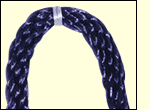 Most forms of rope harness begin by locating the center of the rope you’re using. To make this easier, once you’ve found the midpoint of your rope, tie a small piece of thread or string around it; that way, you never have to search for it again. Most forms of rope harness begin by locating the center of the rope you’re using. To make this easier, once you’ve found the midpoint of your rope, tie a small piece of thread or string around it; that way, you never have to search for it again.
|
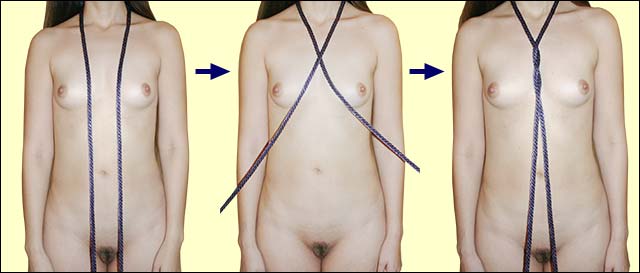
First, find the center point of the rope. The center of the rope drapes around the back of the person’s neck. Bring the ends of the rope around one another three times; these three twists will become the three diamonds you see in the front of the finished rope harness.
Bring the two ends of the rope between the person’s legs…
…then up and apart on the other side. From this point, each end of the rope will wrap around the person’s hips and then through the lowest twist in front, which sounds complicated but is actually quite easy:
See? Nothing to it. Don’t pull the rope tight; as you continue this process, bringing the ends of the rope around to the front, passing them through the twists, and then bringing them back again, the rope will need to slide to let the diamonds open up in the front. It’s okay if the rope is loose at this point; it will become tighter as you work your way up.
You’ll do the same thing again–pass the ends of the rope around the person’s back, then around the front and through the twist, like so:
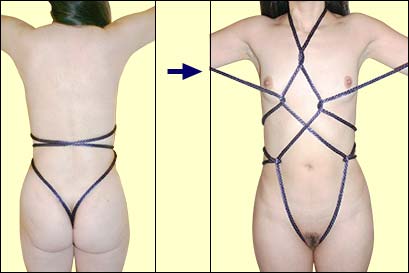
As you might imagine, you’ll do this same thing one more time. Bring the ends of the rope around the person’s body and behind the person, then back around the front and through the topmost twist. After you do this, you can bring the ends of the rope over the top of the person’s shoulders, or back around beneath the persons arms like I show here. (I’ll demonstrate going over the top of the person’s shoulders in the section about making a simple karada using chain instead of rope.)
So the rope goes around to the front of the person’s body, through the topmost twist, then back around behind the person again; from there, you bring the ends up underneath the rope where it passes around the person’s neck, and down beneath the rope wrapping around the person’s back. (It’s easier than it sounds, I promise.)
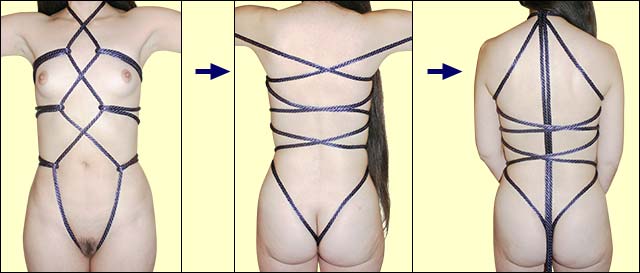
If you’re using a 25′ length of rope, you will probably find that there’s not enough rope left at this point to run down the persons back. No problem; at this point, you just wrap or tie off the ends of the rope wherever you like–around the part where it loops around the back of the person’s neck, or around the part where it crosses behind the person’s back, or whatever.
There are all kinds of things you can do any time you find yourself with extra rope. One of the simplest things you can do is use the extra rope to make a wrap:
It’s exactly as simple as it looks. The free end of the rope wraps around and around another part of the rope; if you reach the end of the rope, just tuck it beneath the wrap. This technique is quite handy for making "handles" that are quite convenient for grabbing, if you like.
For some more things you can do with a longer piece of rope, stay tuned for the next installment.
|
|
|
|
|
Just got a new loft for my apartment from Ikea, which comes in two boxes and about ninety-five parts, so I’m likely going to be spending the next couple of days putting it together–something I’m most decidedly not looking forward to. Not that that has anything to do with anything.
Like this:
Like Loading...

 Most forms of rope harness begin by locating the center of the rope you’re using. To make this easier, once you’ve found the midpoint of your rope, tie a small piece of thread or string around it; that way, you never have to search for it again.
Most forms of rope harness begin by locating the center of the rope you’re using. To make this easier, once you’ve found the midpoint of your rope, tie a small piece of thread or string around it; that way, you never have to search for it again.

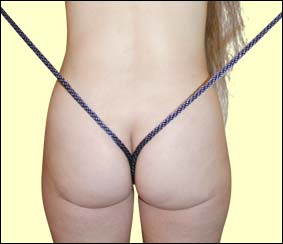
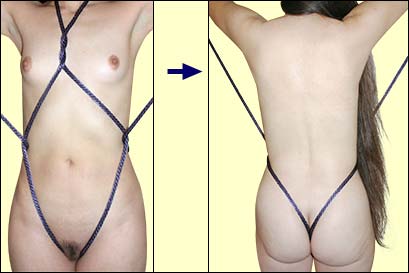


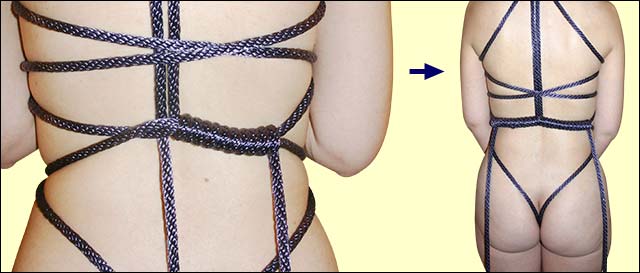
What’s that used for? It would seem to offer an awful lot of freedom of motion for bondage purposes.
These -karada shibari- feel like being hugged, IME.
Some styles provide stimulation to the Nether Regions, too.
They are used as a foundation, sometimes.
A basic rope harness offers complete freedom of motion, but it has more…devious uses as well.
The ropes in most karadas are designed to move and shift against the more sensitive bits of the bound person’s anatomy as that person moves around, which can create some rather interesting results. In fact, you can tie a karada using thin rope or twine and then wear it under clothes, and it will remind you it’s there all the time.
They’re also very pretty to look at. I tied a karada on Shelly before a play party one night, and she went to the party wearing it under her dress; when she took the dress off, she got a lot of admiring attention.
The karada itself doesn’t restrain the person wearing it, but it can easily be used as a restraint. You can, for example, bind a person to a bed by weaving ropes through the karada and around the bed, or restrain a person by tying their wrists or arms to the karada, or binding their arms behind their back and weaving the rope tying their arms through the ropes that come up between their legs. If oyu use a long rope like this one, you can take the ends of the rope, which are about 6′ long after this karada was made, and use them to do a frog tie, which immobilizes someone very effectively–that’ll be Part 2 of this tutorial.
You can even take two or more people wearing karadas and tie them together in virtually any position you can think of by weaving ropes through and around the karadas.
And finally, a karada offers many places to grab nd hold the person wearing it, which is great fun of and by itself. I like doing wraps on the bottom part of the karada because it provides convenient handles that I can grab if the person is bent over and…well, you get the idea.
hi
i would like to chat about this on msn
bibabe609@hotmail.co.uk
luv fiona
xx
What’s that used for? It would seem to offer an awful lot of freedom of motion for bondage purposes.
Things learned from this:
1. looks really good naked.
2. How to make a basic rope harness.
Awww, ::blushing::
Yeah, I gotta agree here..
I’m still absorbing the first lesson. . . .
Things learned from this:
1. looks really good naked.
2. How to make a basic rope harness.
Hey great!
That’s a different style from those I’ve learned 🙂
Hey great!
That’s a different style from those I’ve learned 🙂
These -karada shibari- feel like being hugged, IME.
Some styles provide stimulation to the Nether Regions, too.
They are used as a foundation, sometimes.
Awww, ::blushing::
very nicely done tutorial!
Thanks! I’m working on a large number of other similar tutorials, which will eventually become an entire new wing at the Symtoys Web site (which is getting a facelift as part of the process as well), but it’s slow going.
very nicely done tutorial!
Ohhh! I’m gonna try!!!
Ohhh! I’m gonna try!!!
I’m such a rebel. I looked at this at work!
Well, it helps when you work at a place whose IT Morlocks also dig nekkid women… 🙂
I’m such a rebel. I looked at this at work!
Well, it helps when you work at a place whose IT Morlocks also dig nekkid women… 🙂
Thanks! I’m working on a large number of other similar tutorials, which will eventually become an entire new wing at the Symtoys Web site (which is getting a facelift as part of the process as well), but it’s slow going.
A basic rope harness offers complete freedom of motion, but it has more…devious uses as well.
The ropes in most karadas are designed to move and shift against the more sensitive bits of the bound person’s anatomy as that person moves around, which can create some rather interesting results. In fact, you can tie a karada using thin rope or twine and then wear it under clothes, and it will remind you it’s there all the time.
They’re also very pretty to look at. I tied a karada on Shelly before a play party one night, and she went to the party wearing it under her dress; when she took the dress off, she got a lot of admiring attention.
The karada itself doesn’t restrain the person wearing it, but it can easily be used as a restraint. You can, for example, bind a person to a bed by weaving ropes through the karada and around the bed, or restrain a person by tying their wrists or arms to the karada, or binding their arms behind their back and weaving the rope tying their arms through the ropes that come up between their legs. If oyu use a long rope like this one, you can take the ends of the rope, which are about 6′ long after this karada was made, and use them to do a frog tie, which immobilizes someone very effectively–that’ll be Part 2 of this tutorial.
You can even take two or more people wearing karadas and tie them together in virtually any position you can think of by weaving ropes through and around the karadas.
And finally, a karada offers many places to grab nd hold the person wearing it, which is great fun of and by itself. I like doing wraps on the bottom part of the karada because it provides convenient handles that I can grab if the person is bent over and…well, you get the idea.
i would imagine that it morlocks would like to look at nakid chicks, as they usually dont get to. i could be wrong.
i would imagine that it morlocks would like to look at nakid chicks, as they usually dont get to. i could be wrong.
I’m still absorbing the first lesson. . . .
Technical Question..
First, I appreciate the step-by-step. I have a Shibari book, but have not yet been able to shift through all the school/work books that I read to get to that.. The step by step is just enough to pique my interest, and make me want to try this on a friend of mine..
The technical question: Is there much of a rope difference in length when it comes to BBWs? I know that it will take more, but you’re leaving an extra 15 feet for fun stuff in the next tip. Do you have experience with doing rope work with larger ladies, and how much of a difference does it make?
Thank you very much!!!
Re: Technical Question..
Oh, and where do you buy your rope at? 😀
Re: Technical Question..
Cheapest place I’ve found is right down at Home Depot, believe it or not. They stock rope in a variety of different textures and widths, and even colors; the rope in the pictures here is dark purple nylon (the color doesn’t show up well on my digital camera) and is very soft. You can have it cut to any length; they charge by the foot.
Re: Technical Question..
Should tell people to go over what they’re buying by hand, they get the rope from different sources & of different qualities.
Re: Technical Question..
It does make a little bit of difference, but not as much as you might think. You might find it convenient to work with a 35′ length rather than a 25′ length if you’re doing a basic harness, or a 50′ length rather than a 40′ length for doing a harness with frog tie; that’s quite a bit of extra rope, but you can always simply wrap any excess length.
Technical Question..
First, I appreciate the step-by-step. I have a Shibari book, but have not yet been able to shift through all the school/work books that I read to get to that.. The step by step is just enough to pique my interest, and make me want to try this on a friend of mine..
The technical question: Is there much of a rope difference in length when it comes to BBWs? I know that it will take more, but you’re leaving an extra 15 feet for fun stuff in the next tip. Do you have experience with doing rope work with larger ladies, and how much of a difference does it make?
Thank you very much!!!
Re: Technical Question..
Oh, and where do you buy your rope at? 😀
Re: Technical Question..
It does make a little bit of difference, but not as much as you might think. You might find it convenient to work with a 35′ length rather than a 25′ length if you’re doing a basic harness, or a 50′ length rather than a 40′ length for doing a harness with frog tie; that’s quite a bit of extra rope, but you can always simply wrap any excess length.
Re: Technical Question..
Cheapest place I’ve found is right down at Home Depot, believe it or not. They stock rope in a variety of different textures and widths, and even colors; the rope in the pictures here is dark purple nylon (the color doesn’t show up well on my digital camera) and is very soft. You can have it cut to any length; they charge by the foot.
Asphixiation hazard?
This is a great example of a simple harness, clearly explained, and beautifully documented! I look forward to the next installment!
I do have one concern, however, in that, if you are going to use this harness for further fun, there is a potential strangulation hazard in the twist below the throat. It appears that the neck loop could be tightened without limitation by pulling on just about any other part of the harness. Perhaps a warning to the inexperienced might be in order?
Re: Asphixiation hazard?
I can see where it looks like that might be the case, but in reality, I don’t think it’d be possible. The rope that comes down the front of the body to the first twist has downward tension on it; the ropes coming around the sides holding the diamonds open exert a downward force. The rope in front can’t move upward, and there’s no slack on it, so it won’t actually tighten around the throat.
Re: Asphixiation hazard?
More commonly then this method, people will use a series of overhand knots.
When properly positioned, the first knot makes the neck loop big enough to slip over the head.
Not only will this give you a much better sense of security about strangulation, it will also allow you to keep the harness mostly constructed for future play sessions.
If anyone has any questions, feel free to email me at archmastergarn at gmail dot com.
Re: Asphixiation hazard?
This is the same design you helped chain me up in at Necro, if that helps for reference at all. The rope is all being pulled down by the side “ties”. The twist looked like it was near my throat, but that was before the rope was pulled between my legs. It was easier to hold the twists up high to prevent the twists from “travelling” downwards and end up with a twist between my legs instead of in front where they should be.
Plus, since it’s rope, the design can “slide” around, which means that if the diamonds are not exactly where you want them on the body, you can slide the side-rope along the diamond edge to reposition it. By doing this to all three diamonds, you would in effect, lengthen the V around the neck, placing the top of the upper diamond lower on the chest than it shows in the picture.
Asphixiation hazard?
This is a great example of a simple harness, clearly explained, and beautifully documented! I look forward to the next installment!
I do have one concern, however, in that, if you are going to use this harness for further fun, there is a potential strangulation hazard in the twist below the throat. It appears that the neck loop could be tightened without limitation by pulling on just about any other part of the harness. Perhaps a warning to the inexperienced might be in order?
Re: Asphixiation hazard?
I can see where it looks like that might be the case, but in reality, I don’t think it’d be possible. The rope that comes down the front of the body to the first twist has downward tension on it; the ropes coming around the sides holding the diamonds open exert a downward force. The rope in front can’t move upward, and there’s no slack on it, so it won’t actually tighten around the throat.
Re: Asphixiation hazard?
This is the same design you helped chain me up in at Necro, if that helps for reference at all. The rope is all being pulled down by the side “ties”. The twist looked like it was near my throat, but that was before the rope was pulled between my legs. It was easier to hold the twists up high to prevent the twists from “travelling” downwards and end up with a twist between my legs instead of in front where they should be.
Plus, since it’s rope, the design can “slide” around, which means that if the diamonds are not exactly where you want them on the body, you can slide the side-rope along the diamond edge to reposition it. By doing this to all three diamonds, you would in effect, lengthen the V around the neck, placing the top of the upper diamond lower on the chest than it shows in the picture.
Re: Technical Question..
Should tell people to go over what they’re buying by hand, they get the rope from different sources & of different qualities.
Yeah, I gotta agree here..
Re: Technical Question..
Greetings, and welcome aboard!
Re: Technical Question..
Greetings, and welcome aboard!
Neat! It’s like origami!
Neat! It’s like origami!
Awesome. I’ll be getting some rope and trying this.
Mods? Can this go in the memories?
Thanks!
Whoops. This isn’t in sextips. My bad. Haha
Awesome. I’ll be getting some rope and trying this.
Mods? Can this go in the memories?
Thanks!
Whoops. This isn’t in sextips. My bad. Haha
Stumbled across this while searching for how to tie a crotch rope. It’s very beautiful looking, and very easy. I did it on myself in a few minutes.
Howdy! Searching on LiveJournal, or searching on Google?
Searching on Google. It didn’t occur to me to search on LiveJournal until I saw this. You really should continue the series, I have a lot of fun learning your ties.
Stumbled across this while searching for how to tie a crotch rope. It’s very beautiful looking, and very easy. I did it on myself in a few minutes.
Howdy! Searching on LiveJournal, or searching on Google?
Searching on Google. It didn’t occur to me to search on LiveJournal until I saw this. You really should continue the series, I have a lot of fun learning your ties.
Just wanted to say thanks for this, I’ve just learned how to tie it and I forsee this being a useful skill 🙂
It’s a surprisingly useful skill, really. 🙂 Thanks!
Just wanted to say thanks for this, I’ve just learned how to tie it and I forsee this being a useful skill 🙂
It’s a surprisingly useful skill, really. 🙂 Thanks!
Long time no see!
Wow, Tacit… haven’t seen you (or Onyx, or Xero) in a *very* long time! I was poking around looking for rope harnesses, and stumbled onto your blog. Nice work!
Chabouk
Re: Long time no see!
Thanks! 🙂
Onyx is now at version 3.0, and the Symtoys Web site now has a bunch of tutorials on rope bondage, sensation play, and that kind of stuff.
Long time no see!
Wow, Tacit… haven’t seen you (or Onyx, or Xero) in a *very* long time! I was poking around looking for rope harnesses, and stumbled onto your blog. Nice work!
Chabouk
Re: Long time no see!
Thanks! 🙂
Onyx is now at version 3.0, and the Symtoys Web site now has a bunch of tutorials on rope bondage, sensation play, and that kind of stuff.
out of curiosity
My master has been dabbling with rope bondage with me… but he doesn’t like the harness that most show how to do online because it gets in the way of the ass or the pussy… any ideas to how to find a “tutorial” on a similar harness but one that instead of going between the ass cheeks and then around the sides of the pussy.. that maybe it just comes down to tie around the thighs? please email to shaitaana@gmail.com if you have any sites or etc that you know of or know how to do it and have a pic by pic instructions please.
Re: out of curiosity
I don’t have any pics handy of a style of karada that does what you want. It’s fairly simple to do; you bring the ropes around the wearer’s hips rather than between the legs. Maybe next time is in town and I have a chance to do some pics, I’ll do a shoot with that variant of karada and put it up.
Re: out of curiosity
ooo very kewl thanks I appreciate that 😀
Re: out of curiosity
I’d be happy to help experiment with this!
out of curiosity
My master has been dabbling with rope bondage with me… but he doesn’t like the harness that most show how to do online because it gets in the way of the ass or the pussy… any ideas to how to find a “tutorial” on a similar harness but one that instead of going between the ass cheeks and then around the sides of the pussy.. that maybe it just comes down to tie around the thighs? please email to shaitaana@gmail.com if you have any sites or etc that you know of or know how to do it and have a pic by pic instructions please.
Re: out of curiosity
I don’t have any pics handy of a style of karada that does what you want. It’s fairly simple to do; you bring the ropes around the wearer’s hips rather than between the legs. Maybe next time is in town and I have a chance to do some pics, I’ll do a shoot with that variant of karada and put it up.
Great tutorial.
Are you using twisted or braided rope?
~r
This rope is twisted nylon; same stuff you can find at Home Depot.
Great tutorial.
Are you using twisted or braided rope?
~r
This rope is twisted nylon; same stuff you can find at Home Depot.
Re: out of curiosity
ooo very kewl thanks I appreciate that 😀
hi
i would like to chat about this on msn
bibabe609@hotmail.co.uk
luv fiona
xx
Re: out of curiosity
I’d be happy to help experiment with this!
question???
i have a question.. i tried this particular rope harness on myself.. but it kept comming loose and i had to keep moving around.. and ih ave to apply the harness myself.. how do i stop it from comming so loose?
Re: question???
Where is it coming loose? It sounds like you may not be wrapping tightly enough, particularly around the hips and sides. (This kind of harness is difficult to get into yourself.)
question???
i have a question.. i tried this particular rope harness on myself.. but it kept comming loose and i had to keep moving around.. and ih ave to apply the harness myself.. how do i stop it from comming so loose?
Re: question???
Where is it coming loose? It sounds like you may not be wrapping tightly enough, particularly around the hips and sides. (This kind of harness is difficult to get into yourself.)
hmm maybe
ya i think your right.. it kept pulling on my neck i didnt want to make it to tight either so probably but as i was walking around it all started loosening up when i thought it was all really tight ill probably have to just work on it im sure ill get it eventually!
hmm maybe
ya i think your right.. it kept pulling on my neck i didnt want to make it to tight either so probably but as i was walking around it all started loosening up when i thought it was all really tight ill probably have to just work on it im sure ill get it eventually!
wow, I was looking for a repelling rope harness… man was I suprised lol
yea, I was looking to make a safety harness for the deer stand.
wow, I was looking for a repelling rope harness… man was I suprised lol
this woman looks well lovely
this woman looks well lovely
Male version of harness
Firstly, wonderful tutorial. Really easy and still an attractive result.
A question for you though: Would you modify this for guys? Passing the rope between the legs won\’t be quite the same. I\’ve one idea but I\’d like to hear your ideas.
Re: Male version of harness
Does this help?
Male version of harness
Firstly, wonderful tutorial. Really easy and still an attractive result.
A question for you though: Would you modify this for guys? Passing the rope between the legs won\’t be quite the same. I\’ve one idea but I\’d like to hear your ideas.
Re: Male version of harness
Does this help?
Re: Asphixiation hazard?
More commonly then this method, people will use a series of overhand knots.
When properly positioned, the first knot makes the neck loop big enough to slip over the head.
Not only will this give you a much better sense of security about strangulation, it will also allow you to keep the harness mostly constructed for future play sessions.
If anyone has any questions, feel free to email me at archmastergarn at gmail dot com.
thanks
yup, that’s very helpful. It doesn’t have the nice knotlessness of the original, but is useful and easy to follow.
thanks
yup, that’s very helpful. It doesn’t have the nice knotlessness of the original, but is useful and easy to follow.
I can tell you from using it. look’s are deceiving.
while this can be very sexy wear for a sub,it can and does provide many different bonding points on the body. with the rope being wrapped around it’s self in the back it makes for a secure tying area. great guide by the way,love the purple rope
I can tell you from using it. look’s are deceiving.
while this can be very sexy wear for a sub,it can and does provide many different bonding points on the body. with the rope being wrapped around it’s self in the back it makes for a secure tying area. great guide by the way,love the purple rope
yea, I was looking to make a safety harness for the deer stand.
ropestep4.jpg seems to not be loading, either on lj, or directly
Hmm. Must have been a server glitch–it seems to be working now.
Grazie!
And the model is gorgeous.
ropestep4.jpg seems to not be loading, either on lj, or directly
Hmm. Must have been a server glitch–it seems to be working now.
Grazie!
And the model is gorgeous.
thanks
that was fun-
http://img4.imageshack.us/img4/8128/008wp.jpg
thanks
that was fun-
http://img4.imageshack.us/img4/8128/008wp.jpg
Love it.
My girlfriend recently did a twisted rope harness for me; I loved it. It looked a bit different than the example you show here, but this one is also lovely.
I ran across your blog looking for an example of a rope harness like R did for me; I won’t lift your images without your permission, but I just wanted to comment and say that I like what I’ve seen of your blog – your tags make me think that we think a lot alike. 😉
Love it.
My girlfriend recently did a twisted rope harness for me; I loved it. It looked a bit different than the example you show here, but this one is also lovely.
I ran across your blog looking for an example of a rope harness like R did for me; I won’t lift your images without your permission, but I just wanted to comment and say that I like what I’ve seen of your blog – your tags make me think that we think a lot alike. 😉
Shibari.
Love It!
Shibari.
Love It!
I really like the instructions, but I’m curious why you went with a composite rope. Do you prefer natural or synthetic fibers for the karada?
I don’t actually have a preference one way or the other. Some folks really feel passionately about the type of rope they use; me, not so much.
This particular rope is super-soft and comfortable to wear, which is why I used it.
I really like the instructions, but I’m curious why you went with a composite rope. Do you prefer natural or synthetic fibers for the karada?
I don’t actually have a preference one way or the other. Some folks really feel passionately about the type of rope they use; me, not so much.
This particular rope is super-soft and comfortable to wear, which is why I used it.